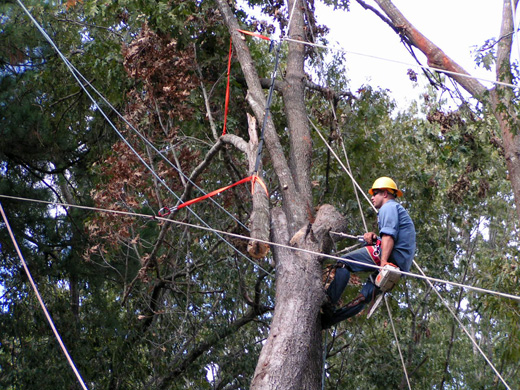
ALWAYS ASSUME THAT POWER LINES ARE ENERGIZED!
• If clearing trees, contact the utility company to discuss de-energizing and grounding or shield- ing of power lines.
• Extreme caution is necessary when moving lad- ders and other equipment around downed trees and power lines.
• Always perform a hazard assessment of the work area prior to start of work.
To “fell a tree” means more than just cutting it down. Felling means to cut the tree in such a way that it falls in the desired direction and results in the least damage to the tree.
To safely fell a tree, you must: Eliminate or mini- mize exposure to potential hazards found at the tree and in the surrounding area.
• What hazards are present in the area where the logger will be working.
• Determine the felling direction and how to deal with forward lean, back lean, and/or side lean.
• Provide a retreat path so the logger can reach safety while the tree is falling.
• Determine the proper amount of hinge wood to safely guide the tree in its fall.
• Proper felling methods allow the logger to safe- ly fell the tree.
• Look out for Hazards and make sure you know where everyone is located!
• Always use proper personal protective equip- ment as recommended by the manufacturer’s operating manual, including eye, face, head, hand, and foot protection.
• Broken or hanging branches, attached vines, or a dead tree that is leaning. All of these hazards can cause an injury.
• If you have to cut a dead tree, be careful. The top could break off.
• If the tree is broken and under pressure, make sure you know which way the pressure is going. If not sure, make small cuts to release some of the pressure before cutting up the section.
• Be careful of young trees that other trees have fallen against. They act like spring poles and can propel back. (Many professional loggers have been hurt in this manner.)
• A tree may have not fallen completely to the ground and be lodged against another tree. Extreme care must be taken to safely bring the trees to the ground.
• If possible, avoid felling into other trees or objects. Don’t turn your back on the tree as it falls, and hide behind a standing tree if possible.
• As trees fall through other trees or objects, branches and objects may get thrown back towards logger.
More people are killed while felling trees than during any other logging activity. These accidents CAN be avoided!
This is one in a series of informational fact sheets highlighting OSHA programs, policies or standards. It does not impose any new compliance requirements. For a comprehensive list of compliance requirements of OSHA standards or regulations, refer to Title 29 of the Code of Federal Regulations. This information will be made available to sensory impaired individuals upon request. The voice phone is (202) 693-1999; teletypewriter (TTY) number: (877) 889-5627.
